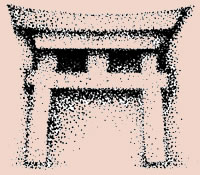
Geisha (GAY sha)
Geisha means art-person. A geisha is a young Japanese girl specially trained
in the arts of singing, dancing, conversation, and forms of hospitality.
She can be hired by a man to serve as his companion. In Madame Butterfly,
Cio-Cio-San is a geisha.
Buddha (BOO duh)
Budda means enlightened one. It is the title given to the founder of Buddhism,
one of the largest religions in the world, especially practiced throughout
East Asia. Buddhists, followers of Buddhism, apply the title of Buddha
to someone they regard as embodying divine virtue and wisdom. The founder
of Buddhism was Siddhartha Gautama, a religious philosopher and teacher
who lived in India around 563-483 B.C. Buddhism teaches that right thinking
and self-denial of desires and worldly things will enable the soul to
reach Nirvana, a state of complete happiness and peace. (Eastern religions,
unlike Western religions, are not exclusive. One can follow both Shinto
and Buddhism.)
Japanese Writing Style
The Japanese form of writing is a highly skilled art. It requires the
use of a brush to be able to make heavy and light lines. The Japanese
borrowed the Chinese system of writing which is made up of thousands of
intricate characters that stand for words, not for sounds. Characters
are written starting at the top of the page and working down.
Shinto (SHIHN toh)
Shinto, which means the way of the gods, is the oldest surviving religion
of Japan. Shintoists worship many deities or gods, which they refer to
as kami. They believe kami to be the basic force in nature: mountains,
trees, rivers, and even humans, dead or alive. Their belief that gods
(kami) can take human form is tied to the history of the origin of Japan
and the ancestry of Japan's imperial family and the divinity of the emperor.
According to Shinto mythology, the god Izanagi and the goddess Izanami
(in Madame Butterfly, Suzuki prays to these gods in the beginning
of Act II) gave birth to the Japanese islands, and then Izanami, while
washing his nose and his eyes, produced the sun goddess Amaterasu. The
grandson of Amaterasu, Ninigi-no-Mikoto, was designated to rule over Japan.
It was his great-grandson Jimmu who became the nation's first Emperor.
Successive emperors were venerated as direct descendants of the gods and
held sacred authority as the symbolic fathers of Japan's national family.
A wooden gate known as a torii (drawing above) is the symbol of Shinto.
It stands at the entrance of a Shinto shrine. The crossbars symbolize
the earth and the posts represent pillars that support the sky. Statues
which represented the souls of ancestors' Shinto worship are referred
to as ottoke. (In Madame Butterfly, Pinkerton ignorantly calls
them pupazzi - little puppets.) A Shinto priest is known as a Bonze.
Jigai (JIG ai)
Jigai is the Japanese word for female ritual suicide performed by cutting
the jugular vein with a sword. The male version of ritual suicide is known
as seppuku (hara kiri) and is performed by cutting one's abdomen with
a short sword. This extremely painful practice, which dates back to the
ninth century, was the only way for a high-ranking Japanese of the military
class to avoid facing disgrace and to remove a blot on his honor. Westerners
frequently refer to this practice as hari kari; a slang term used incorrectly.
CIO-CIO-San performs the ritual of jigai in Madame Butterfly.
Mikado (mih KAH doh)
Mikado was the ancient title of the Emperor of Japan. The word mikado
actually comes from the Japanese word that means exalted gate. This demonstrates
the reverence that the Japanese people held for their ruler. Japan's ruling
dynasty is considered by many historians to be the oldest in the world,
with the reign of Jimmu, the first mikado, dating back to 660 B.C. (see
Shinto). In the A.D. 500's, after Chinese civilization came to Japan,
the Japanese began to call their Emperor Tenno, which means heavenly emperor.
The emperor is never referred to by his personal name. Gilbert and Sullivan
wrote an operetta set in Japan and called it "The Mikado."
Shosi (SHO je)
Shosi are sliding screen panels made of translucent rice paper mounted
on a delicate wooden frame. They are used in Japanese homes as partitions,
doors, and even as walls.

